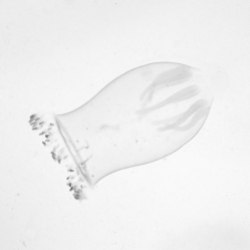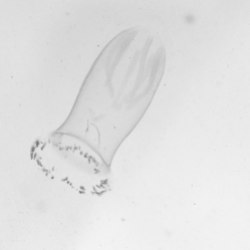I have many photographs of tiny sea jellies that I’ve been meaning to post. Simple studies of their beautiful forms and details. I find converting them to black and white emphasizes these details nicely and I like the way they almost look like drawings here. (Some of them are indeed working their way into drawings.)
This first set is Hydromedusae Aglantha. The jellyfish pictured here is only about 1cm long. If you look closely you will notice the tentacles are mostly contracted into tight spirals in these images. I have previously posted images in colour here, but for some really beautiful photographs of Aglantha (with extended tentacles) go to Alexander Semenov’s flicker page. And if you have a bit of time to get lost in the sea, visit his incredible website.
[These photographs were made in Cape Breton in the spring of 2012]
© Karen McRae, 2013






Ghostly.
They are, I guess. Sea ghosts…
These are beautiful Karen. I checked out Alexander Semenov’s photograph’s. Their amazing.
Thank you, Allen. His work is gorgeous, isn’t it? I’m glad you had a chance to take a peek.
Nicely delicate and beautifully set off in the circular frame format. Which sort of gives them an ‘old fashioned’ illustration of the natural world look. Lovely.
Thanks, Steven. Yes, I was playing with the gallery format and although I don’t usually use it I thought this worked nicely for this set. I like your description.
fascinating and thanks for the link 🙂
I’m glad you checked out his work, it’s pretty astounding. Thanks, Helen.
Very beautiful. Post more. These are underappreciated organisms.
Thank you, I’m glad you like these – I have quite a few more to post (of other jellies).
Karen – these are beautiful images, so simple on first look, then more complex. I remember the shots that you’d previously posted in color (they are among my favorites of your work) and it is so interesting to see how much different the character of the organisms is in color v. b&w.
I’m glad you like them, Melinda, thank you.
It does change them quite a bit – because I was working with them in some drawings I thought they might be worth a revisit. (Plus, I have many variations I didn’t post that I find interesting)
The variations could be your own, Karen, in drawing them and imagining others. I am sure that even if you drew imaginative ones they might be close to the real thing. A whole other universe out there it seems. Lovely, tiny little photos. Alexander’s website was fascinating as well. I think it is great that people spend time learning about these things and share with others.
There is a whole other universe out there, and it’s interesting!
Yes, his work is quite something, I’m glad you liked it.
super!
Thank you!
A superb gallery of defined fragility, almost like peering into petri dishes . . .
It was a white bucket – a good sized petri dish, I guess!
Thanks, Patti.
Less is decidedly more. The simple shapes are so very appealing. And the black and white, simply superb.
Thank you, Elena. I think the black and white is interesting, I’m glad you like them!
Intriguing and elegant…would love to see any drawings which may evolve from these.
Thank you John, I’m not sure my drawings will be that great but if there is something I like, I’ll post it.
Remarkable images Karen. Fascinating and so delicate. Hope to see the drawings.
They are so delicate -barely there – I think that’s part of what make them so interesting. I’m glad you like them, thank you. Maybe some drawings will be posted… : )
Staggeringly beautiful…
They really are beautiful things, thank you!
Hi Karen. I love these shots, and not only because they are interesting photos nicely made, but because I grew up around jellyfish as my dad studied/s them and I used to catch them for him and his colleagues for their research. Aglantha was one of them. Nice to see these photos!
I remember you mentioning that before. Is this part of the work here?: http://www.nobelprize.org/nobel_prizes/chemistry/laureates/2008/shimomura_lecture.pdf
It’s so interesting!
Thanks for your comment, Ehpem, that’s cool that you used to collect these little guys. : )
Ha, I mentioned it already! Well, that shows that my brain cells are aging. Yes, I helped catch jelly fish for that research, 1 cent each, later 2 cents each. I made quite a bit of money over several years. My dad on the other hand did not pay me, I don’t think anyway. But it was fun to catch them and I enjoyed it.
I wonder what sort of sea life you might find with your super macro set up?!
Have you tried that yet? : )
No, I need to keep that one at the front of my mind. There is probably all kinds of stuff. But I would need to bring it home – that rig is not really suitable for outdoors use, too prone to movement, and clumsy and complicated to move around.
I should take a bucket down to the seashore at the end of the block.
Yes, please do, I’d love to see the results!
Simply wonderful, Karen, and thank you for sharing the links to Alexander Semenov’s work – what incredible images!
Thanks very much, Rachel. His work is quite stunning, I’m happy you had a look!
Wonderful! they do look like fine drawings
Thank you!
Your photos always tell a fascinating story! And black and white is the perfect choice. Thanks Karen!
They seem to work nicely in black and white. I’m glad you like them. Thank you, Jan.
Wonderful work as always, Karen, you’re so gifted! The link is a gem, wow! Thanks a lot for presenting Alexander S. to us.
Have a great time.
Love and big hug
Dina
Awe, thanks very much Dina, that’s very kind of you. Yes, Alexander S. does some stunning underwater photography. Thanks for following the link!
xx
Oh my these jelly fishes look absolutely so cute and elegant!!!!
It is a pretty cool looking jelly! Thank you.
Love these Karen, so “scientific” and illustrative..Im fascinated by this sort of sea- life..
I find them fascinating too. I guess that’s obvious. : )
I’m glad you like them, Cath – there will be more!
I like how these fascinatingly alien creatures are almost not there at all. And the B&W seems to emphasise their delicacy. I wonder what they think about. Beautiful shots.
They really are barely there, and difficult to spot in the ocean! I’m glad you like the black and white.
I don’t imagine they do a lot of thinking since jellyfish have no brain! : ) But if they did … ?
What lovely little objects! They are begging to become drawings, I do hope we get to see them! (Have been away so not keeping up with your posts, just skimmed through the last few, beautiful work as always – love the progression of the flower heads.)
Thanks very much, Anna. These forms are pretty interesting. Very much like a vase of flowers. (It’s difficult to keep up with blog stuff sometimes!)
The monochrome really emphasises the magic of the forms. Wonderful.
Thanks, Alessandro, the forms are quite something. : )
These photos are great – I’ll be looking out for more. And as the other bloggers have said, thanks for the introduction to A.Semenov. I have painted & drawn microscopic sealife, plankton and diatoms, this year and in the past – so it is very exciting to see how someone else does it. And in an original way. Brilliant 🙂
Thank you, Jo. These type of life forms are inspiring for artwork, aren’t they? I’m glad you enjoyed the post and Alexander’s brilliant work.
Wonderful, Karen – I might have guessed these were drawings you had made, too! Possibly (in part) because I had no idea how you would go about photographing these fascinating creatures (so I really enjoyed finding out a bit more in the comments above). Amazing work! 🙂
Thanks very much, SIG. I wish my drawings were that well done!
I’m happy you like these. : )
Thanks Karen!
I look forward to seeing your drawings – and I am thinking about jewellery myself!
Oh, I’d love to see jewelry inspired by these sea creatures! : )
Thank you, Dominique.
They do look like scientific illustrations – when you use a really hard pencil on vellum. Delicacy defined. I enjoyed the color photos, and Alexander’s website – wow – the jellyfish against a starry sky – I don’t usually like that kind of thing, but that is such a great image, and anyway, how different are the sky above and the oceans below? Thanks for the links!
I’m glad you checked out the links – his work is quite something.
Thanks for your comments, Lynne.